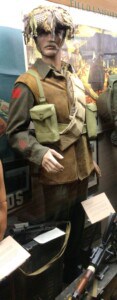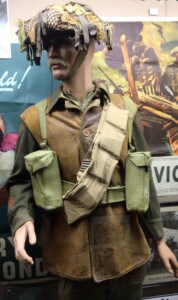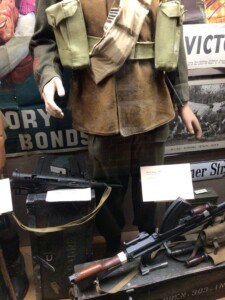Battle Dress NW Europe, 1944-45: Steel helmet – lining – net covering – camouflage strips; khaki shirt; khaki battle dress – blouse and trousers; chamois sleeveless over jacket; blue putties; ankle boots; khaki bandoleer across chest with 5 pockets for hand grenades; water bottle & case; entrenching tool case; rain cape; large pack. Service stripes on sleeve near cuff; 1st Division red patch at the top of sleeves
First issued just prior to going overseas in October 1939. Battle Dress ended the Highland practice of wearing kilts in battle.
During the initial months of the war web accoutrements were in short supply so the 48th continued to wear the webbing worn in the First World War. Along with a shortage of accoutrements was a shortage of web gaiters, so the Regiment equipped itself with blue half putties.
The Private here wears a leather jerkin for cold, wet weather. Draped across his chest is a bandoleer of extra ammunition. Under his helmet net is a shell dressing.
Battle Dress – As part of a rapid Canadian rearmament in 1939 the regiment received a new uniform, the British Battle dress. To the helmet of the First War, a net was added to soften the shape for camouflage. The Battle dress introduced a new khaki tunic, universal to all ranks and cut as a short blouse similar to a lumber jacket. Brass, plain, olive-drab buttons, covered over by a fly front, replaced regimental buttons. The tunic had two breast pockets with hidden buttons and an adjustable waistband cuff. A stand and fall collar, as in Service dress, was open with shirt and tie for officers and closed for the men. Brass collar-badges were eliminated, as were regimental numerals on the epaulets. Officers’ rank was sewn in cloth on the epaulets and men’s rank on the sleeve. Regimental identity was reduced to a cloth shoulder title ‘48th Highlanders” sewn on the shoulder seams. This unit title was approved for the 1st Canadian Infantry Division in December 1940 to replace the ‘Canada’ shoulder title.
The uniform introduced the Highlanders to trousers, versus the kilt of WWI, to which the blouse was attached by buttons to keep it from riding up at the back. Two exterior pockets, a large map pocket on the left, and a small one on the right to carry a field dressing, were part of the trouser. A buttoned tab gathered the legs, and around the ankles the 48th Highlanders wore blue putties, the only way to identify a Highlander from a distance. Web anklets, or gaiters, were the official dress for the Canadian army. However, the Commanding Officer had managed to have the King comment favourably upon the Highlanders’ blue putties at an inspection in England and they became official for the regiment. Underneath the putties, ankle boots continued. The ’37 Pattern webbing brought minor changes for the soldier: ammunition pouches capable of holding the 30 round magazine for the Bren gun and a new waist belt. Officers also wore this web with some unique items such as a pistol case, ammunition pouch and haversack.
The distinction between officers and men had been virtually eliminated as had that between the English and Scottish regiments. The officer retained a few traditional symbols, his distinct accoutrements, pistol and shirt and tie. To the “48th Highlanders” shoulder title were added the words “of Canada” as the lone marker of national identity. The Division patch was brought back and the 48th became the only battalion in the 1st Division to wear the “red patch” in both World Wars.



